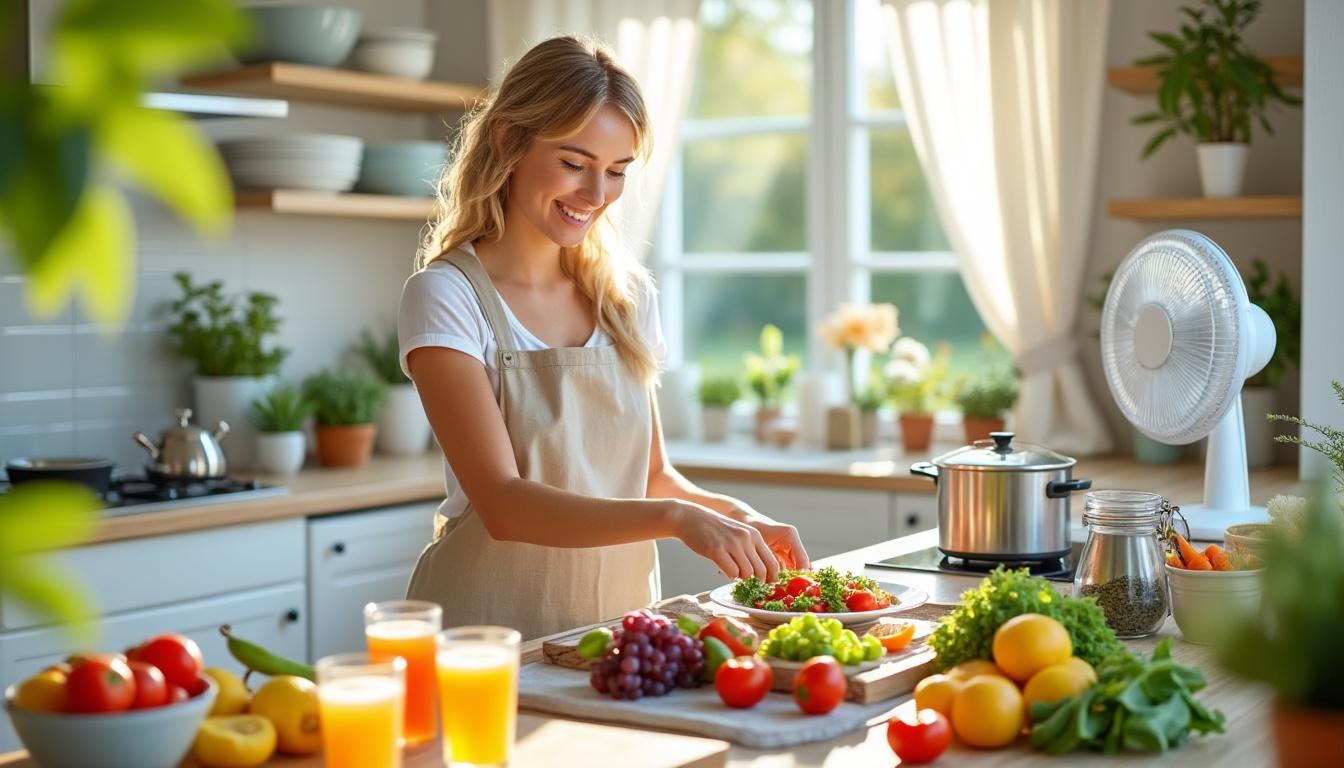As summer 2025 ushers in record-breaking heat waves across the United States, the challenge of cooking in a sweltering kitchen intensifies. Temperatures soaring into the triple digits make the thought of turning on a stove or oven daunting. Yet, preparing meals at home remains essential for health, taste, and budget. Fortunately, various proven strategies and kitchen technologies can help maintain cooler cooking environments and reduce energy bills. This guide reveals nine effective methods to beat the summer heat in your kitchen by leveraging smart appliance choices, cooking schedules, and innovative cooling techniques without compromising delicious meals for your family.
Maximizing Kitchen Comfort by Choosing the Right Cooking Appliances
Summer’s relentless heat requires a strategic approach to appliance usage. Traditional ovens and stovetops emit significant heat, exacerbating kitchen temperatures and discomfort. Opting for modern, energy-efficient appliances like the Instant Pot, Breville air fryer, or KitchenAid compact devices can significantly reduce this heat output.
The Instant Pot, for example, uses pressure cooking technology to shorten cooking times, reducing the duration your kitchen warms up. Devices like the Breville air fryer or Ninja countertop ovens can replace traditional methods by cooking crisp, flavorful meals with less emitted heat. The Cuisinart food processors and blenders also enable preparation of no-cook dishes and cold treats, which help keep the kitchen temperature down.
Smaller appliances typically emit less heat and consume lower electricity, aiding in energy conservation during the hottest months. For instance, slow cookers from brands like Hamilton Beach and multitasking devices such as Pampered Chef grills bring versatility while maintaining an optimal kitchen environment.
- Utilize pressure cookers and slow cookers for efficient meal preparation.
- Replace oven use with air fryers or toaster ovens to minimize radiant heat.
- Leverage blenders for smoothies, cold soups, and fresh sauces to avoid heating.
| Appliance | Heat Output | Ideal Use in Summer |
|---|---|---|
| Instant Pot | Low | Pressure cooking, batch meals |
| Breville Air Fryer | Moderate | Frying, baking with less heat |
| KitchenAid Blender | Minimal | Cold food prep, smoothies |
| Hamilton Beach Slow Cooker | Low | Slow cooking dishes |
| Ooni Pizza Oven (outdoor) | Not applicable (outdoor use) | Grilling and baking outdoors |
How To Optimize Appliance Selection For Hot Weather
Plan your kitchen tasks around appliances that give off minimal heat. Prioritize batch cooking meals in pressure cookers or slow cookers. When grilling outdoors with an Ooni pizza oven or barbeque, avoid heating the indoor space altogether. This approach not only preserves cool kitchen air but also helps in reducing energy costs, a critical consideration during peak summer months when air conditioning usage spikes.
More about efficient grilling methods can be found through reputable guides such as those emphasizing safe grilling of chicken and steak ensuring food safety while managing outdoor heat.
Implementing Smart Kitchen Ventilation and Airflow to Beat Heat
Effective air circulation plays a crucial role in mitigating heat accumulation in the kitchen. A vigorous exhaust fan above the stovetop, especially from trusted manufacturers like KitchenAid, can swiftly remove steam, smoke, and excess heat. Its function goes beyond odor control—it actively draws hot air out, preserving a cooler cooking environment.
Combining exhaust fans with supplementary household fans enhances airflow. Positioning a fan near a window or door can push hot air outdoors. For added cooling, place a damp towel or a bowl of ice before the fan to circulate cooled air. This tactic mimics an improvised air conditioner without the high energy expense.
- Always activate the exhaust fan while cooking to vent rising heat.
- Use oscillating fans or tower fans to create ambient air movement.
- Create cross-ventilation by opening windows and doors strategically with fans.
| Ventilation Method | Effectiveness | Energy Consumption |
|---|---|---|
| Exhaust Fan (KitchenAid or equivalent) | High | Moderate |
| Oscillating Tower Fan | Moderate | Low |
| Cross-ventilation Setup | High | None |
Additional insight on how to optimize airflow in home kitchens is available via reliable resources on home and garden outdoor exploration.
Leveraging Outdoor Cooking as a Cool Kitchen Strategy
Taking cooking outdoors represents one of the most effective ways to avoid indoor heat accumulation. The rise of consumer-friendly outdoor appliances like the Ooni pizza oven or traditional grills powered by well-known brands allows preparation of delicious, summer-friendly foods while keeping indoor areas fresh and cool.
Grilling meats, vegetables, or even fruits such as watermelon outdoors reduces the heat load inside, preventing air conditioning costs from inflating. Safe grilling practices remain paramount, with instructions accessible via official USDA grilling safety guidelines to avoid foodborne illnesses while enjoying outdoor cooking.
- Use an Ooni pizza oven to bake artisanal pizzas conveniently outdoors.
- Opt for charcoal or gas grills from brands like Black+Decker for versatile outdoor cooking needs.
- Grill seasonal vegetables, corn on the cob, or fruit slices for fresh, cool accompaniments.
| Outdoor Cooking Appliance | Fuel Type | Best Use |
|---|---|---|
| Ooni Pizza Oven | Wood/Charcoal | Artisanal pizza, baking |
| Black+Decker Gas Grill | Gas | Meats, vegetables grilling |
| Pampered Chef Smokeless Grill | Electric | Indoor/outdoor grilling |
For convincing recipes suitable for hot weather and grilling, visit easy recipes for home cooks that focus on outdoor techniques.
Timing and Meal Preparation: Cooking Smarter to Stay Cool
Strategically timing cooking sessions during cooler hours of the day, such as early morning or late evening, can greatly reduce kitchen discomfort. By avoiding meal preparation during peak heat periods, the kitchen remains relatively cooler, minimizing the cumulative effect of heat generation.
Batch cooking presents another effective strategy. Preparing larger meals during cooler parts of the day with appliances like the Instant Pot enables multiple meals from one cooking session. This method also cuts down on repeated kitchen heat exposure throughout the day. Using pre-prepared leftovers facilitates quick, no-cook assemblies during hotter hours, conserving energy and your personal comfort.
- Cook during morning or late evening hours to avoid peak daytime heat.
- Batch cook versatile dishes like pulled chicken or stews in Instant Pot.
- Store precooked meals for easy access during hottest daytime periods.
| Cooking Time | Benefits | Recommended Appliances |
|---|---|---|
| Early Morning | Cooler ambient temps, lower energy | Instant Pot, slow cooker |
| Late Evening | Reduces heat buildup overnight | Air fryer, grill |
| Batch Cooking | Efficient meal prep, less heat buildup | Instant Pot, slow cooker |
For further guidance on meal planning and cooling kitchen strategies, explore weekly meal plans that align with heat wave cooking techniques at ChatGPT weekly meal plans.
Essential Hydration and Lighting Tips for a Comfortable Cooking Environment
Staying hydrated is essential not only for health but also for managing heat stress while cooking in warm kitchens. Consuming between 11 to 15 cups of water daily is advised during high heat periods, with the addition of electrolytes like lemon and sea salt enhancing hydration efficacy.
Lighting also contributes substantially to ambient heat. Minimizing bright, overhead lights and utilizing energy-efficient, dimmable smart bulbs from brands like Tefal can reduce the heat contribution from artificial lighting. Closing blinds to block direct sunlight further aids in temperature control.
- Drink plenty of water throughout cooking to maintain hydration.
- Use dimmable, low-heat smart lighting to reduce ambient heat.
- Close curtains or blinds during peak sun hours to block heat.
| Tip | Benefit | Recommended Products |
|---|---|---|
| Hydration with infused water | Maintains electrolyte balance, refreshes | Reusable water bottles, soda water makers |
| Smart dimmable lighting | Reduces heat load, energy efficient | Tefal smart bulbs |
| Sunlight management | Keeps indoor temperatures cooler | Blinds, curtains, shades |
Frequently Asked Questions About Keeping Kitchen Cool in Summer
- Can small appliances truly keep my kitchen cooler during summer?
Yes, smaller energy-efficient appliances like Instant Pot, air fryers from Breville or Ninja, and slow cookers from Hamilton Beach generate significantly less heat than conventional ovens and stovetops, helping keep your kitchen cooler. - Is outdoor grilling the best way to avoid kitchen heat?
Absolutely. Using outdoor grilling appliances such as Ooni pizza ovens or Black+Decker gas grills transfers the heat source outside, preventing indoor temperature spikes and providing delicious summer meals. - How does meal timing impact kitchen temperature?
Cooking during cooler morning or evening periods reduces the heat present inside your kitchen, making the cooking experience more comfortable and energy-efficient. - What’s an effective way to improve kitchen airflow?
Installing a high-capacity exhaust fan and using oscillating fans to create cross-ventilation effectively removes trapped heat, smoke, and odors, keeping the kitchen environment refreshing. - What hydration strategies help when cooking in hot conditions?
Staying well-hydrated with water and electrolyte-infused drinks like lemon and sea salt mixtures helps maintain body temperature and energy, reducing heat-related fatigue during kitchen time.

